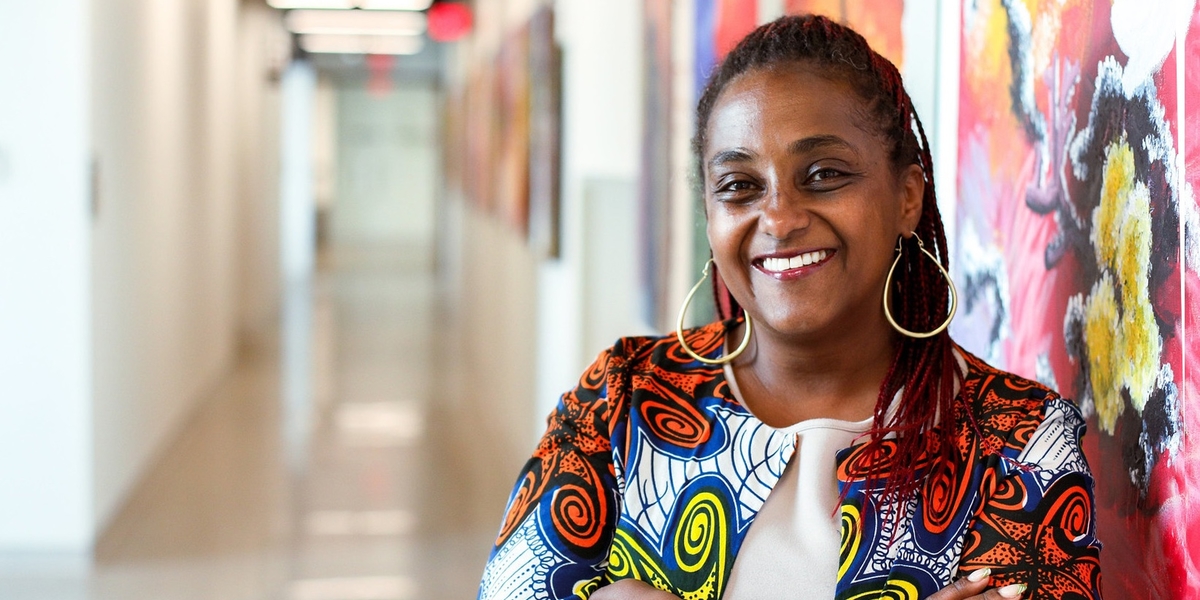
Tseganesh Selameab (B.S. Microbiology, ’99; M.D. ’04) loves the Minnesota State Fair. During the sultry days marking the end of summer break, she makes her way there early and often. She grew up walking distance from the fairgrounds and still lives close by. Her favorite part? The people. “People are amazing. I randomly talk to people from all kinds of walks of life at the fair,” she says. “There are so many different perspectives.”
Selameab connects with others effortlessly. Her outgoing, ebullient personality serves her well as a physician and educator, but she didn’t always see it that way. “In medical school, I would get feedback about how good I was with people and I hated it!” she says. “I thought ‘there’s no way you can be good with people and be a good doctor.’” Only praise for technical skills counted. Her view has evolved in parallel with changes in medicine and medical education.
“As a doctor, I need to be good at my job, I need to be competent, but I also need to see my patients as human, I need to be kind, I need to connect with them,” says Selameab. “The more I did that, the more I realized this is a highly valuable part of what I do.”
Now an associate director in the University of Minnesota Medical School’s Center for the Art of Medicine, Selameab teaches courses on becoming a doctor and immigrant refugee global health, and works on integrating diversity, equity and inclusion into the curriculum more broadly. She trains students to reflect on their own humanity through writing, art, music, storytelling and other means. “Physicians are human beings who are part of a community,” she says. “Understanding ourselves within that context is transformative.”
The move toward applying a more humanistic lens to medical training is driven, in part, by the high number of physicians leaving the field and suffering from depression. “Our jobs are really, really hard,” says Selameab. ‘We witness difficult things and have to make decisions in spaces that are complicated.”
Early in her career, Selameab compartmentalized her love for storytelling and poetry, spending free time pursuing those passions. Eventually, the interests converged. She told a story at an American College of Physicians conference titled “My Inner White Man,” which deconstructs expectations about how a physician relates to patients.
The performance sparked a chain of events that culminated in the creation of an animated short film produced for Twin Cities Public Television called Art + Medicine: Advocating Diastole. Diastole refers to the point during a heartbeat when the heart muscle relaxes, allowing the chambers to fill with blood. Selameab uses this as a metaphor for a more authentic state of being, one that better serves patients and physicians alike.
Selameab went on to collaborate on Art + Medicine: Speaking of Race. She’s since led efforts to organize two live storytelling events at the Parkway Theater in Minneapolis in collaboration with The Nocturnists Podcast, which describes itself as “a vibrant community of healthcare workers who are celebrating their humanity through storytelling.”
Finding community has always been important to Selameab. Her family emigrated to the United States from Ethiopia when she was 12. She spent many years working with immigrant and refugee patients, and feels a strong affinity with those communities based on her own experience.
As a fledgling undergraduate in the College of Biological Sciences, she felt like a “misfit and a nerd,” but quickly found a way to connect with her science-minded peers through participation in the Biology Colloquium, a student-run career exploration course, which she took more than once. Among her fondest memories were regular trips to Itasca Biological Station and Laboratories as part of the course. “It was a chance to get in nature to learn something, but it was really just to hang out with people my own age.” she says. “Those experiences grounded me.” — Stephanie Xenos